We cover all you need to know to make a decision about either
- buying a bike pedal strap to use in your own cycling, or
- deciding on a manufacturer to produce your own
CONTENTS
How Do Bike Pedal Straps Work?
How Necessary Are Bike Pedal Straps?
Bike Pedal Straps vs Toe Clips
Pedal Strap Brands
HOW DO BIKE PEDAL STRAPS ACTUALLY WORK?
Here’s a close look at the anatomy of a pair of bike pedal straps that SCADA has on the market.
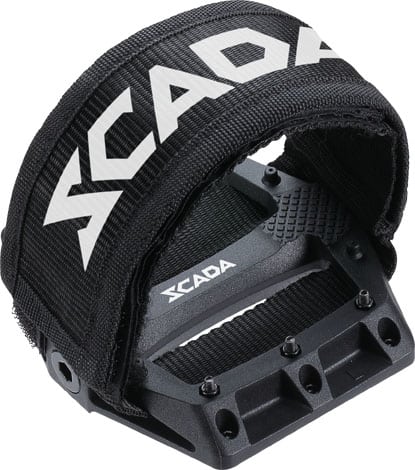
We manufacture the pedal — since that’s our core business — and work with another company to produce the straps which can be fitted to any suitable pedal.
The image shows a basic flat pedal design with two levels. The space in between allows a strap to be threaded through.
It’s not the only style of strap (for example the Power Grips brand covered below), although most straps on the market are of this type.
The Strap Itself
Bike pedal straps thread into a platform pedal and are fastened together by double-sided, overlapping velcro strips.
It works like this:
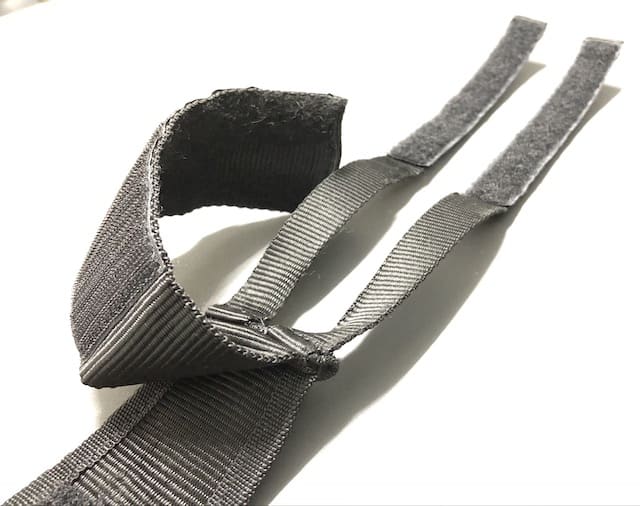
The main strap which fits over the top of a shoe is secured in place by two double-sided velcro straps.
The double-sided twin straps fit through the pedal body, which secures the whole strap to the pedal body.
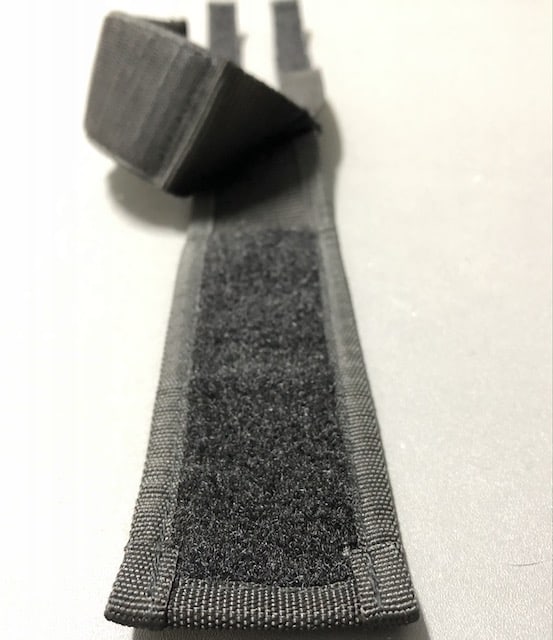
A third piece wraps around onto the top of the twin straps, locking the unit together.
Velcro is a dependable binding material over time, although it will eventually wear out.
The key variable is the durability of the stitching where both sides of the binding are joined.
Quality stitching will see a pair of straps lasting as long as the velcro holds out.
Strap and Pedal as a Unit
Bike pedal straps are designed for use on a platform pedal that is not one piece.
There is no prohibition on using flat pedals on any bike, so straps can be used in any kind of riding situation (for serious sport and racing, clipless is safer of course).

The twin straps are designed to thread through the platform, one in each half of the platform.
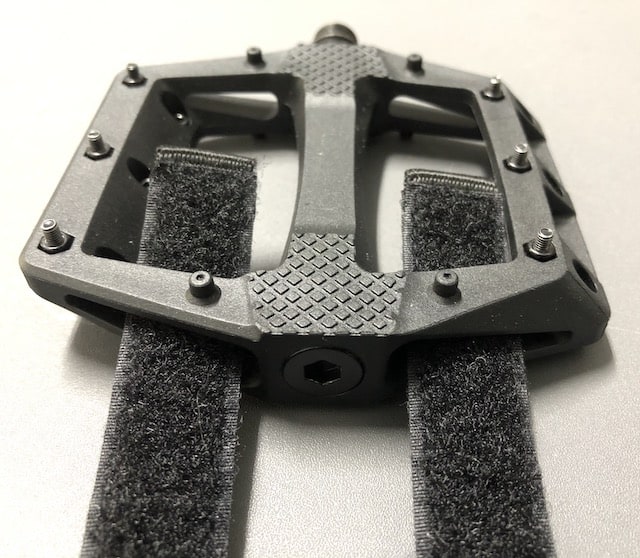
The gap will be wide enough in every platform pedal—as long as there is a gap.
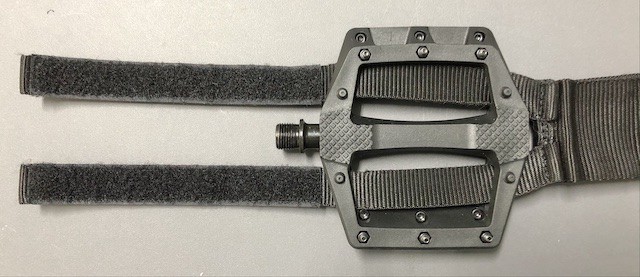
With the two straps inserted fully, the main strap is ready to be laid over a shoe—foot on the pedal with the strap laid across the laces.

Like so…imagine a foot under it.
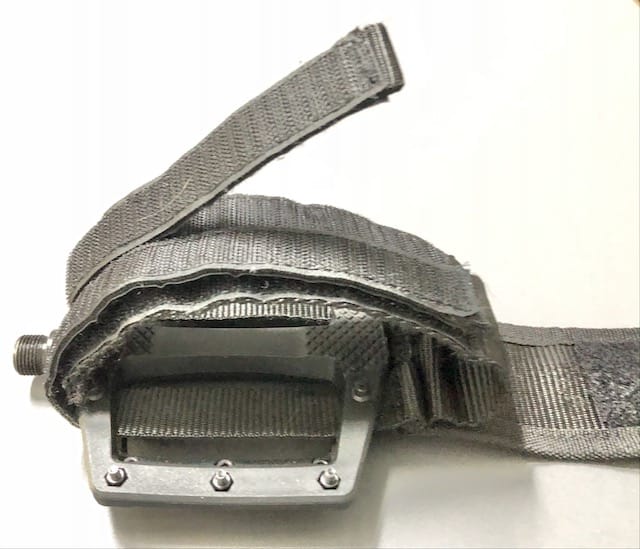
Then the twin strips of double-sided velcro wrap across the top.
The best technique is to ensure a firm fit of the single strap across the shoe which is held in place by the twin straps.
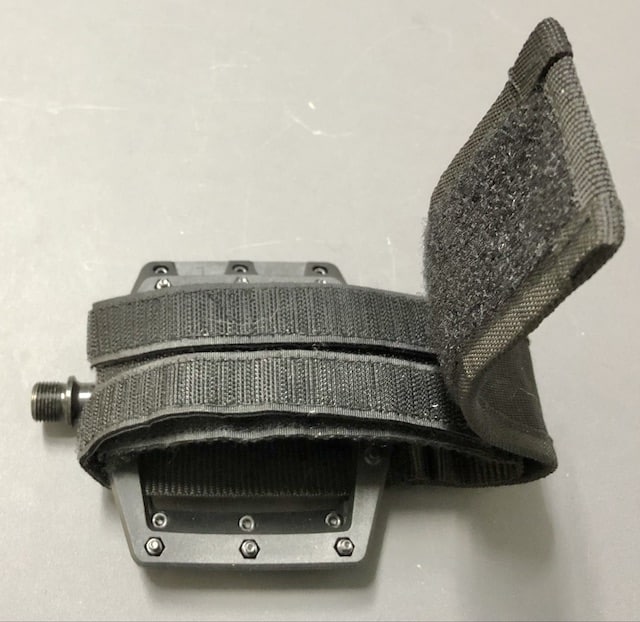
Then the top, single-sided velcro strip lays across the top forming a strong bond which won’t give way, as long as all strips are fitted together properly (and the stitching is strong).
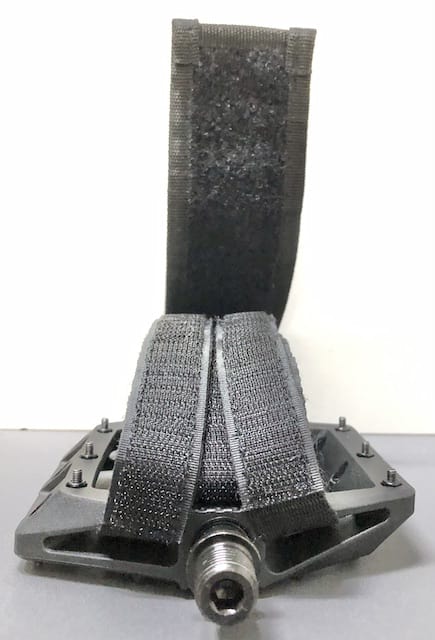
You don’t want that strap on the left skewed to the left like that; it needs to be smack bang in the center to maximize the velcro connection between both.
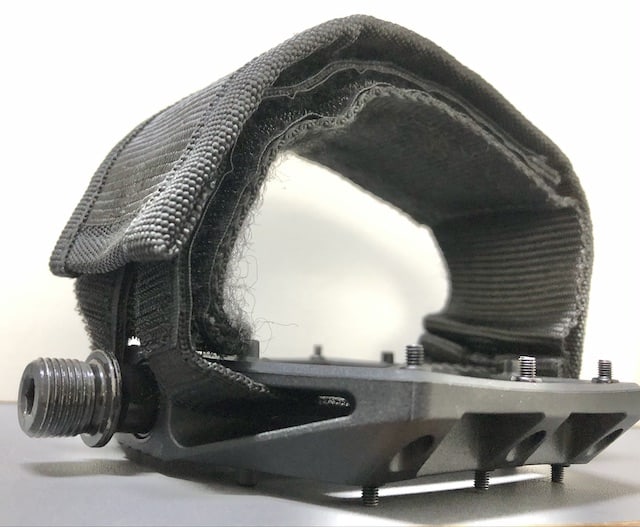
A bike pedal strap mounted with the straps interlocked.
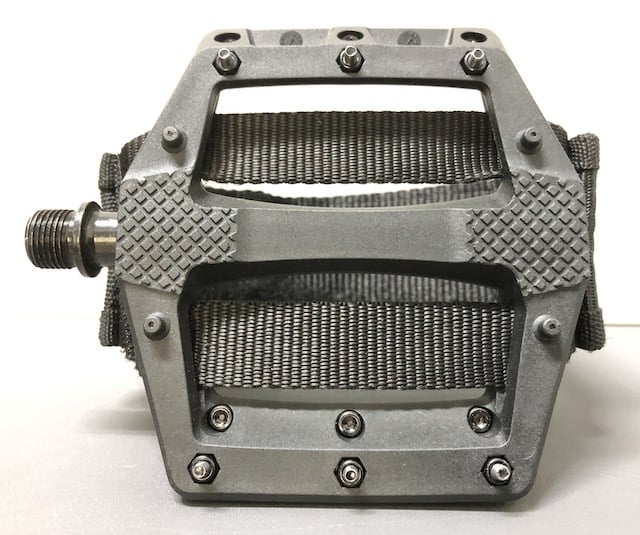
The underside of a pedal showing the straps threading through the pedal body which fix the strap to the pedal.
HOW NECESSARY ARE BIKE PEDAL STRAPS?
They’re not.
But they can assist cyclists in a number of ways.
There is a downside to using them, however . . . the danger of you foot tightly bonded to your bike’s pedals with no quick means of release.
Or a too rapid release should the strap give way which can lead to an instant loss of bike control.
Benefits
There are several benefits for kids and adults.
Children
Pedals fitted with straps are used by parents with children who find it hard to keep feet on the pedals.
This includes special needs children or children generally learning to keep their foot on a pedal which can be more difficult for younger kids. (Note that these straps are hard to fit to smaller pedals…having the right pedal is important.)
Adults
Vigorously riding an exercise bike can result in shoes slipping off the pedals.
Toe clips (which I cover in the next section) are one solution.
Bike pedal straps offer a slightly simpler solution.
Recumbent bike riders also find that closely binding their feet to the pedals with bike pedal straps, even on a steep angle, works well.
Fixed gear, single speed riders around town use straps to more efficiently tackle hills.
A bike pedal strap makes use of the same principle behind clipless (ie. clip-in) pedals: cyclists also gain drive on the upstroke of each pedal cycle, not just the downstroke.
Downside
The downside for kids is nowhere near as dire as for adults.
Children
Some kids find their feet don’t sit naturally square on the pedals, but at an angle, making it uncomfortable — or even impossible — to insert a foot into the strap.
In such a case, bike pedal straps won’t help them learn to ride a bike and use pedals properly.
Adults
Inserting your foot into a binding that is fixed to the pedal often means a one second delay in extracting it in an emergency.
Clipless pedals’ spring loaded brackets are designed to release shoe cleats in a split second, releasing shoes even where a rider is out of control and heading for the pave.
Bike pedal straps, however, require a rider to make a conscious decision horizontally extract their shoe in a crash situation.
That slight delay could result in a more severe injury than might otherwise have occurred.
What’s worse though is if a shoe suddenly releases from a pedal.
The advantage of a strap is the extra leverage you get from being able to pull on the upstroke as well as push on the the downstroke.
Imagine a fixie rider standing on the pedals, perhaps on a slight incline, or even hopping up steps or traversing a similar obstacle in the same way, relying on the upstroke to move the bike in the right direction.
If the velcro releases, or the stitching gives way freeing the foot from firm attachment to the pedal while one pedal is on the upstroke, you’re looking at instant destabilization—the rider will probably pitch forward and to one side, very likely hitting the pavement.
A fall from a height regardless of the speed can easily break bones.
BIKE PEDAL STRAPS vs TOE CLIPS
Are you better off using a toe clip instead of a pedal strap?
From a strictly functional point of view, one is not better than the other.
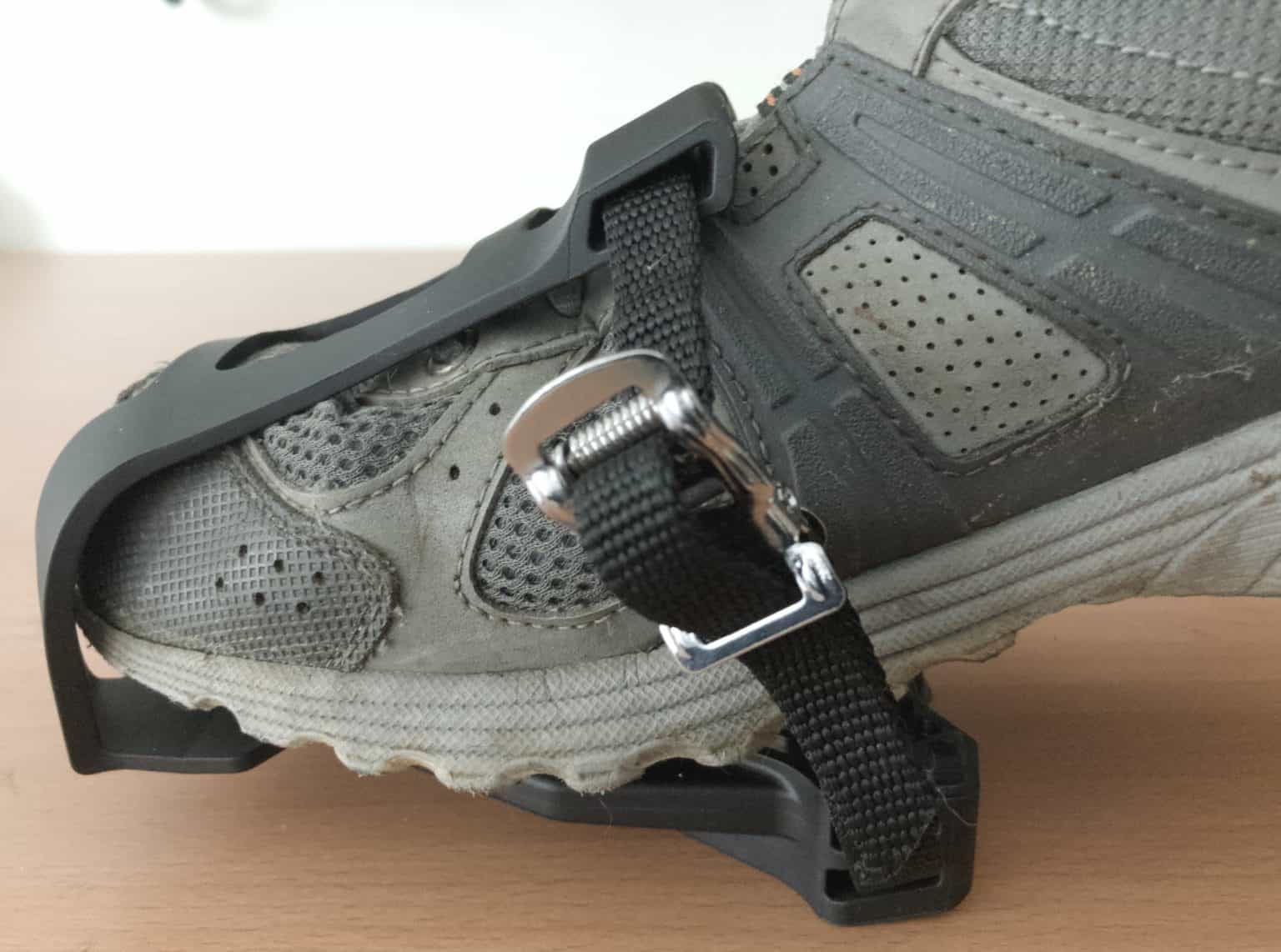
A toe clip prevents a shoe from slipping off a pedal but is arguably more elegant and stylistic.
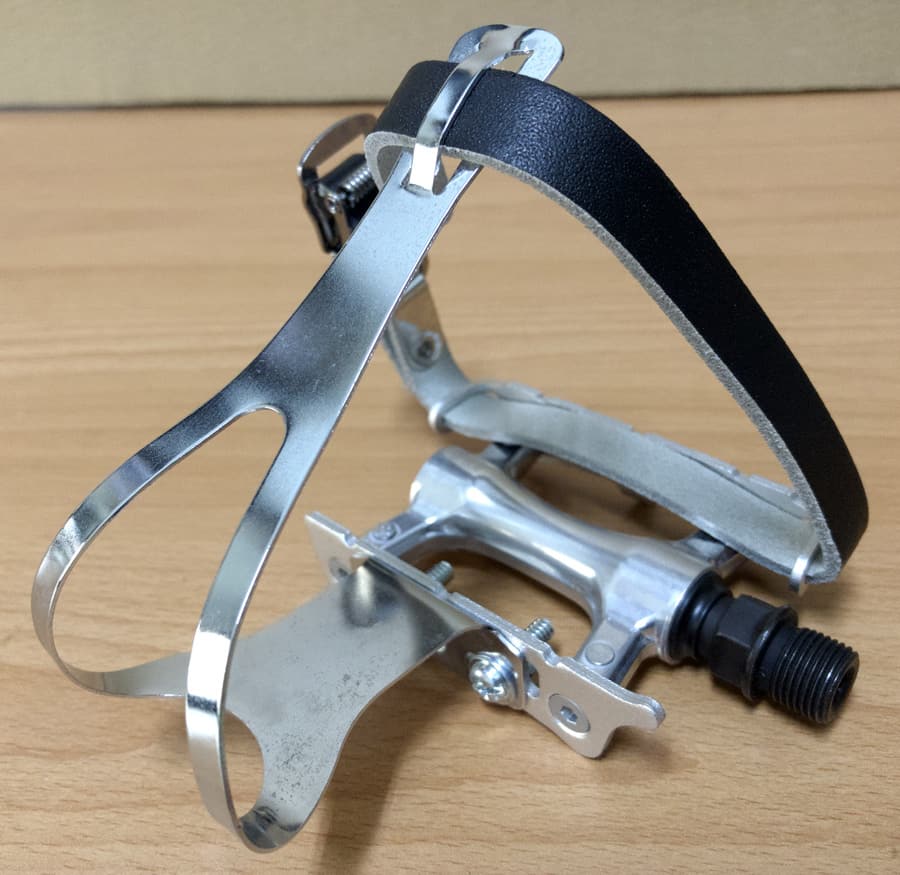
The classical look harks back to the first decades following the invention of the rear drive safety bike.
A pedal strap perhaps has a slight advantage during a pedal upstroke, that normally dead part of the pedal cycle that you can’t take advantage of.
Toe clips are designed for the shoe to rest inside the cage since there is both a cage and a strap for support.
Plus, the cage angles up following the slope of a shoe.
Bike pedal straps rely on a tight fit—the shoe wedges into position and provides, potentially, more leverage pulling on the upstroke.
You could also replace a toe cages that has broken off with a pedal strap rather than replace the toe clip . . . provided you have the correct pedals, a platform design through which you can thread the twin straps.
PEDAL AND STRAPS BRANDS
Glancing over reviews of bike pedal strap products on Amazon reveals that from 1/2 to 2/3 of buyers are entirely satisfied with their purchases.
Causes of dissatisfaction include product performance problems such as poor velcro grip and stitching tearing free, which, of course all depends on how much stress you put on them.
Pedal straps are not meant to deliver the high performance expected of clipless pedals.
The following brands demonstrate the three main designs available in the market.
Power Grips
Power Grips offer two types of strap.

The first bolts onto an entry level cage pedal on opposite sides. You can get a pedal and strap kit, or just opt for the strap.
Designing the strap to fit diagonally across the pedal instead of in line with the axle gives a the cyclist an easier exit in an emergency—back up slightly, then turn your foot inwards.
And if all you’ve got is a pair of cheaper cage pedals, you can still use straps (and see the ZSFLZS below for an axle aligned strap also for one-piece or cage pedals).
The brand also offers a velcro version that is similar to those described above.
Fyxation
Fyxation offers a velcro model with robust stitching and a buckle.

You slip the velcro around the buckle, then fasten it back in the other direction.
They also offer a variety of pedals for anyone looking for a strap and pedal kit.
Onipax
Onipax, a Taiwan designer of bicycles and cycling accessories, has a popular model based on the twin straps and velcro design.
The advantage of this design is the ability to accommodate any sized shoe—attach the velcro straps, then the overlay, ensuring a snug fit.

ZSFLZS and SBYURE are other brands available on a number of online outlets.
The ZSFLZS design doesn’t need a platform pedal; if you’ve got a caged pedal, fitting a strap is easy.
Although, you are limited to the 7 notches: a velcro strap can be snugged around a shoe exactly where you want . . . ball of the foot, slightly behind, or further back.
FINAL COMMENTS
Having described the variety of bike pedal straps available on the market I’ll finish off by mulling over whether a hybrid pedal, in most cases, may be the better choice rather than straps.
You get a more elegant pedal—and the range of styles and functional designs offered by brands seems to be increasing each year.
The cost is higher, granted, since you need to purchase a shoe or boot with a recessed cleat.
But you’ve got the choice of either plain platform, or a quicker and safer way to free a shoe from the connection when you need it.